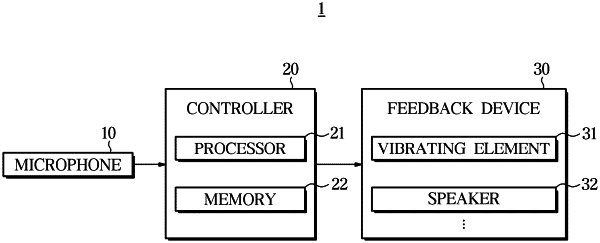| CPC G10L 15/22 (2013.01) [G10L 25/63 (2013.01); G10L 2015/223 (2013.01)] | 16 Claims |

|
1. An emotion adjustment system, comprising:
a microphone configured to receive a user's voice;
a controller configured to extract a plurality of sound quality factors in response to processing the user's voice, calculate a depression index of the user based on at least one sound quality factor among the plurality of sound quality factors, identify an emotional state of the user as a depressive state when the depression index is a preset value or more, determine the depressive state as a first state or a second state based on a correlation between at least two sound quality factors among the plurality of sound quality factors, and transmit a control command corresponding to the emotional state of the user identified as the first state or the second state; and
a feedback device configured to perform an operation corresponding to the control command,
wherein the plurality of sound quality factors comprises a sharpness, a roughness, and a fluctuation strength,
wherein the controller is configured to calculate a noise index of the user's voice based on a correlation between the sharpness, the roughness, and the fluctuation strength, and determine the depressive state as the first state or the second state based on the noise index,
wherein the noise index comprises a rattle index and a squeak index, and
wherein the controller is configured to determine the depressive state as the first state or the second state based on a ratio between the rattle index and the squeak index.
|